Air conditioners are one of the most essential and overlooked systems in a home. They keep the temperature inside comfortable and cool even on the hottest days of the year.
When you notice your AC not cooling efficiently or at all, you should immediately take action. Some AC problems get worse with time and can result in costly repairs or even replacement.
If you want to take good care of your air conditioner, it’s helpful to know the most common problems, which ones you can quickly fix on your own, and which require a professional’s help.
Top 5 Reasons for AC Not Cooling
When your AC isn’t cooling properly or blowing cold air, you might be able to diagnose the problem with a little troubleshooting. Below, we detail the top 5 issues you’re likely to run into with air conditioners.
Some of the issues below are easy to fix yourself, and some require an experienced professional. But don’t worry — we’ll help you determine when to call a pro.
Clogged Filter
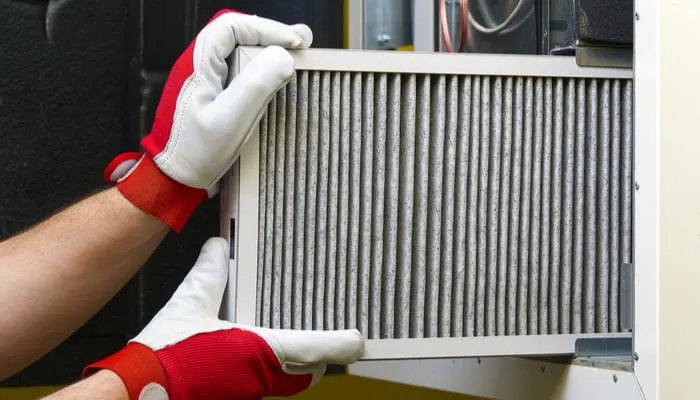
Videst/Shutterstock
Your air conditioner uses an air filter to ensure bits of dust and debris don’t work their way into the system. All air filters need to be replaced. Some every month, some every three months.
But many people fail to keep up with these replacements over time. A clogged air filter won’t allow air to flow through, and no airflow results in your system failing to cool your home.
Turn Off the Ac
The good news is that if a dirty filter is responsible for your AC not cooling, it’s a quick and inexpensive fix that you can handle on your own. Before you get started, turn off the air conditioner and locate your air filter.
Make sure the system is off before you remove the filter – without it in place, more dust and debris will be sucked into your AC. Take a look at the filter size printed on the side of the filter and pick another one up that exactly matches the size.
Vacuum the Filter
Alternatively, if you have a reusable filter with metal sides (not cardboard), you can clean the current filter off by washing or vacuuming it. If the filter appears clean, you can clearly see light through it when you hold it up.
In this case, the filter is probably not the issue resulting in your AC not cooling. Once you’ve either cleaned your reusable filter or purchased another disposable filter in the correct size, you can reinsert it.
Replace the Filter
Pay close attention to the arrows on the filter frame. These show you the direction the air will flow through the filter. Make sure you reinsert it with the arrows pointing in toward the air ducts.
Use a permanent marker to make a note of the date so you can easily see when it’s time to replace the filter again. You can close the grill and latch it closed – you’ve replaced the air filter and can restart the system to see it fixed the issue.
Tripped Breaker or Fuses
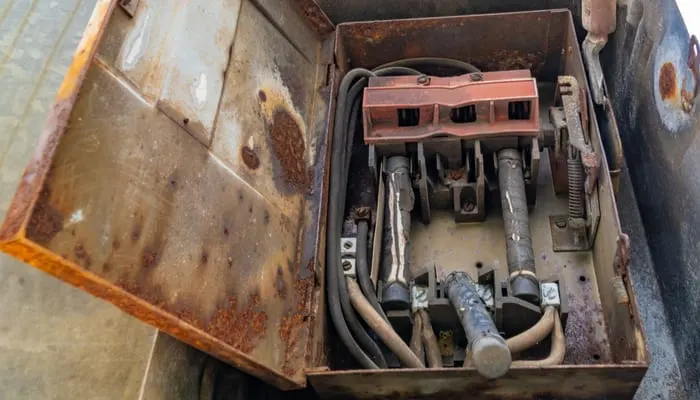
Dimacool/Shutterstock
One of the first things an HVAC technician check is the circuit breaker or fuse panel. It’s a common problem when the system is working hard — the electrical safeguards kick in and trip the breaker to turn it off.
One way to know a tripped breaker or blown fuse could be the culprit is the way your AC stopped working. Was it a hot day where the system was working hard to keep the house cool?
If so, the system could have tripped the breaker or fuse as a safeguard and shut the system down. You can try and reset it by flipping the corresponding switch on your breaker and restarting the system.
If it trips again, there may be an electrical short in the system, so avoid resetting it and call an HVAC technician. After all, the breaker or fuse is shutting off power for a reason — you don’t want to mess with that.
Coolant Leaks or Low Refrigerant
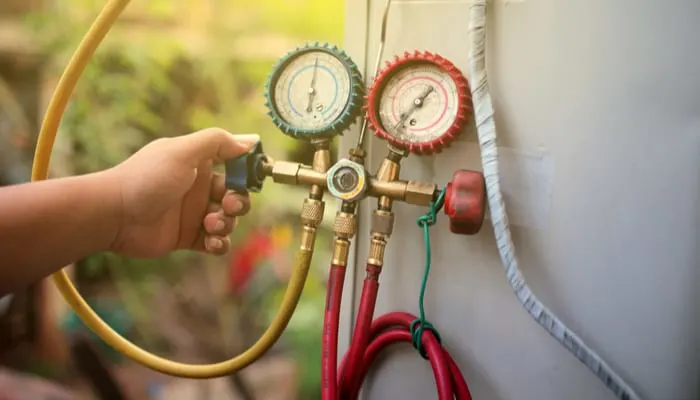
Sutipond Somnam/Shutterstock
Coolant leaks or low refrigerant are common issues that can result in your AC not cooling. If your coolant level is low and no leaks are found, the technician who installed it likely did not add enough coolant.
An HVAC technician can add the proper amount of coolant to restore your AC function as a fast and simple fix. Coolant leaks, on the other hand, must be fixed by a professional and then tested.
You can’t just add coolant because it will leak out again. If the leak is indeed fixed, the technician will need to add refrigerant in the correct amount.
Too much or too little will result in significant problems with your air conditioner (see Compressor below), so your technician follows your air conditioner manufacturer’s specifications for refrigerant amounts.
Broken Compressor
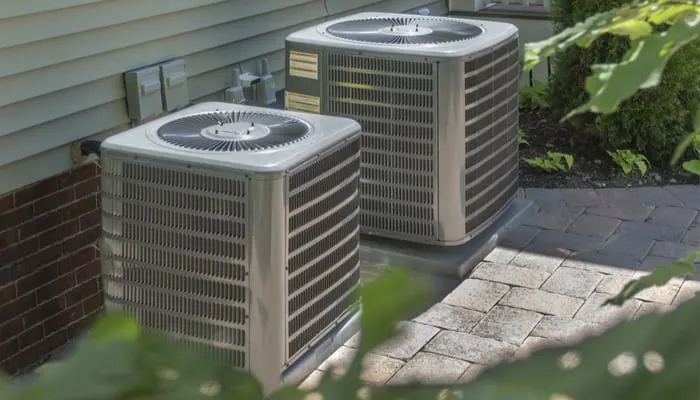
Christian Delbert/Shutterstock
Your air conditioner’s compressor moves the coolant through the coils and is the driving force behind the system’s cooling power. A non-working compressor won’t allow your air conditioner to cool your home.
Your compressor may have one of a few ailments:
- Not enough coolant or refrigerant: The compressor will heat to dangerous levels and seize up
- Too much coolant or refrigerant: The additional coolant returns to the compressor and causes it to shut down
- Compressor and fan controls worn down: These components can wear down over time and need replacement, especially if the system is too large for your home or is turned off and on often
- Electrical contacts and connection corrosion: These electrical components are susceptible to corrosion and should be inspected anytime an HVAC technician comes to your home
For any compressor issues, call an experienced HVAC technician to inspect and diagnose the problem for you. Your technician will quickly identify what the problem is and get it fixed without issue.
But trying to handle compressor repairs or troubleshooting yourself could lengthen the process or result in costly, unneeded parts replacements.
Condenser Coils
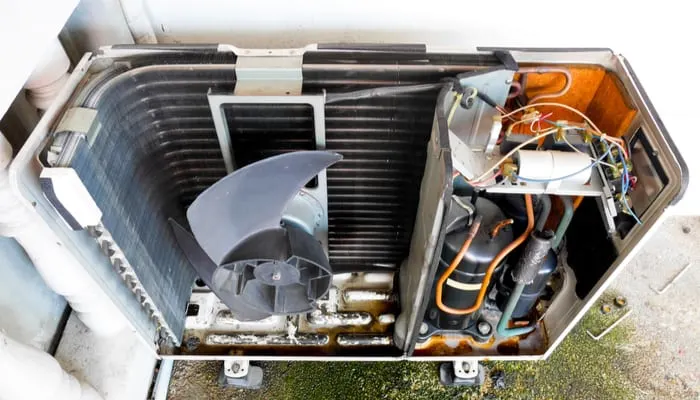
P-Saranya/Shutterstock
Your air conditioner’s condenser coils could be the culprit if your air conditioner is not cooling your home. These coils are located outside where they are exposed to the elements, so they can quickly become dirty.
Dirty coils don’t work efficiently. The dirt that builds up on the coils acts like a physical barrier that separates the air being blown over the coils and the refrigerant being pumped through them by the compressor.
Spray Your Coils
This makes every part of your air conditioning system work much harder to try and cool your home, increasing the chance it will break down and need to be replaced, reducing the cooling power of the system, and increasing your energy bills.
If you maintain your condenser coils’ cleanliness by spraying them off with a hose once or twice a year, you may never have this problem. However, the coils may be too dirty to simply spray off.
An HVAC technician uses a special chemical cleaner to restore them. If dirty coils were the problem, cleaning them off can increase the efficiency of your AC and help it start quickly cooling your home.
AC Repair and Replacement Costs
Air conditioning systems are expensive to replace, and the cost of paying for a repair before the problem worsens is inexpensive in comparison. But how much can you expect to pay?
Below, we’ll go over the national average repair and replacement costs for an AC unit that isn’t cooling. Keep in mind that these rates may be lower or higher in your city.
Service Calls
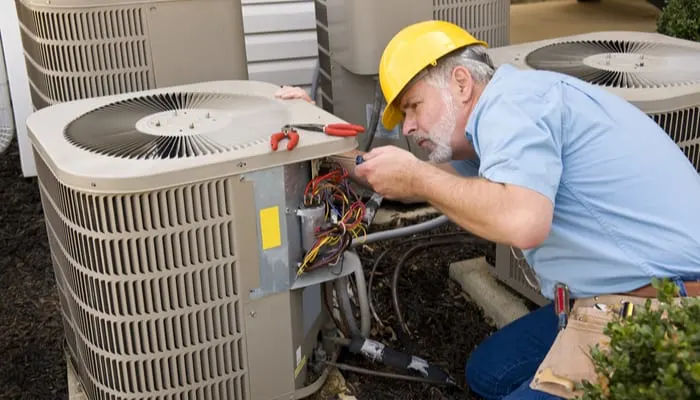
Carolyn Franks/Shutterstock
This is the minimum amount an HVAC company will charge a customer to service an air conditioner. You’ll pay anywhere from $75 to $200 for a service call at a minimum.
AC Diagnostic Call
This is a service call where you’re not sure what is going on with your air conditioner. So the HVAC technician will come out to discover what the problem is and fix it then.
Or, he’ll schedule a time to come back with the proper parts. You’ll pay anywhere from $85 to $110 for a diagnostic call.
Maintenance and Tune-Up
To keep your air conditioner running smoothly and increase its lifespan, you’ll need to schedule regular tune-ups and maintenance calls.
An HVAC technician will inspect and replace any small issues that may pop up in between these visits. You’ll pay anywhere from $85 to $110 per visit.
Compressor Replacement
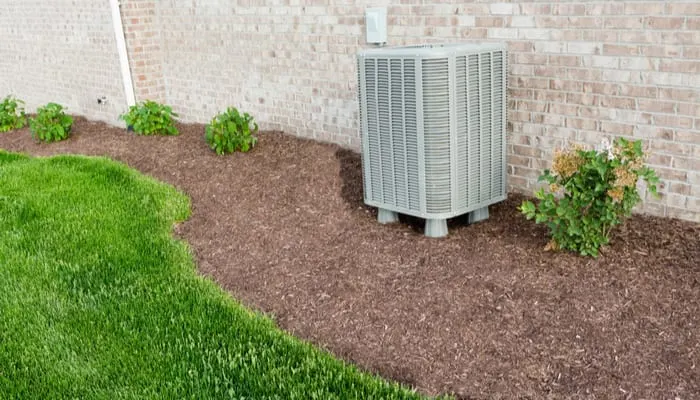
Ozgur Coskun/Shutterstock
This is a big one – if your compressor goes out, an HVAC technician can replace it. Regular maintenance can help you avoid an unnecessary compressor replacement. You’ll pay anywhere from $1,300 to $1,900 for compressor replacement.
Refrigerant/Coolant Recharge
Too little coolant is one reason an AC won’t cool a home. An HVAC technician can “recharge” or add coolant to your AC system for anywhere between $250 and $750.
Refrigerant/Coolant Leak Repair
If you didn’t have enough coolant due to a leak, the HVAC technician can repair the leak and recharge the system with the right amount of coolant. It can cost anywhere from $200 to $1,500.
Condenser Coil Replacement
If your condenser coils are not just dirty but need to be replaced entirely, it’s a much higher cost. You will pay anywhere from $1,900 to $2,900 for condenser coil replacement.
Breaker Repair or Fuse Replacement
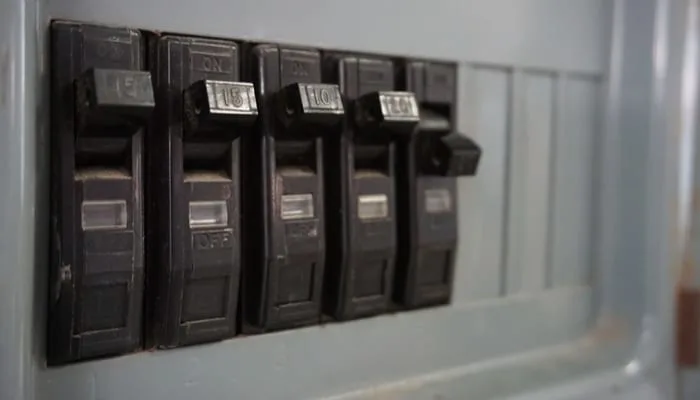
BetterTogether/Shutterstock
Problems with your circuit breaker or air conditioner fuses will cost anywhere from $75 to $290, depending on the type of work needed.
Thermostat Replacement
Replacing your thermostat can solve some problems with an air conditioner not properly cooling. If your HVAC technician says you need a new thermostat, expect to pay anywhere from $75 to $575 for high-end thermostats.
AC Unit Replacement
If there are a host of issues with your air conditioning system or parts that can’t be replaced, your HVAC technician may recommend a full replacement of your AC unit.
This will cost anywhere from $3,350 to $5,900 – a significant expense, and one that makes it worthwhile to pay for regular HVAC maintenance by a professional to avoid needing a full replacement.
AC Still Not Working? When to Call a Pro
However, if the problem is related to your coolant and refrigerant levels, leaks, electrical components, the compressor, or filthy coils that can’t just be sprayed off, you’ll need a licensed HVAC technician to come out and inspect the system.
It’s not only important to call a professional HVAC technician if you have a pressing problem with your air conditioning system. It’s just as important to keep up with regular maintenance!
Some maintenance is easy for you to take care of, like replacing air filters monthly and spraying off your condenser coils once or twice a year.
Other maintenance and tune-up tasks, like checking the thermostat, electrical connections, moving part lubrication, drain lines, and system controls, should always be done by a professional.
When to Call an HVAC Technician
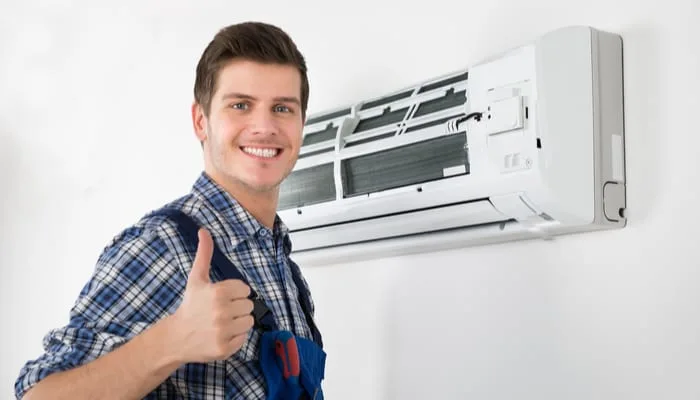
Andrey_Popov/Shutterstock
Clogged filters, breaker or fuse problems, coolant leaks, compressor issues, and dirty condenser coils are the top 5 reasons for an AC not cooling. But not every instance requires a professional to come out and fix the problem.
If the problem turns out to be a clogged filter, tripped breaker, or lightly dirty condenser coils, you can easily handle them without calling in a professional.
Fortunately for you, the Networx form lets you easily connect with a pro to get a free quote. Simply enter your info and wait for a call from a qualified, licensed, and insured rep!
AC Not Working? Connect With a Pro
We hope you’ve found our complete guide to help you troubleshoot an AC not working. While you’re here, be sure to check out our other guides below!

